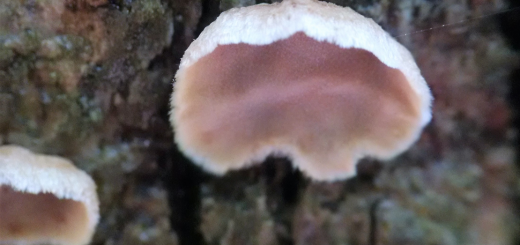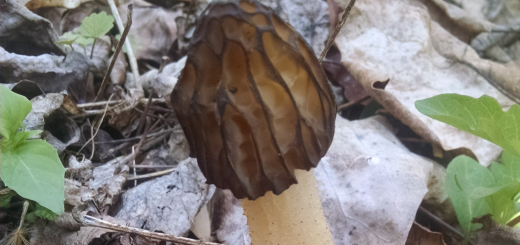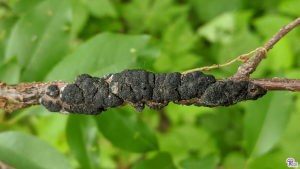#089: Polyporus squamosus, the Dryad’s Saddle [Archived]
Note: This is an archived post. You can find the current version here.
This beautiful, large polypore is a common sight in woods during the spring. You can find it fruiting prominently from the bases of dead trees.
Polyporus squamosus is a shelf fungus that produces large, kidney-shaped to almost circular brackets. The fungus is parasitic or saprobic on hardwood trees – particularly silver maple, box elder, and quaking aspen – and its brackets are often found at the bases of dead or dying trees. You usually find multiple fruitbodies growing from the same stump, but occasionally the mushrooms fruit alone. P. squamosus is called the Dryad’s Saddle because its brackets seem to be perfectly sized and positioned to form a little seat for a weary tree nymph (dryad). I’ve never come across a dryad sitting on one of these mushrooms, but I guess there’s no harm in looking.
If you enjoy hunting, you may know this mushroom by its other common name: the Pheasant’s Back Mushroom. Indeed, the upper surface of P. squamosus is remarkably similar in coloration to a pheasant’s back. The whitish to tan surface is punctuated by numerous, large, dark brown scales. These scales (a.k.a. squamules, thus the species name “squamosus”) are flattened to the pileus and radiate out from a central point, often forming uneven rings. From a distance, this mushroom can easily be mistaken for a pheasant.
The young mushrooms are flask-shaped, with a small pileus topping a slightly thinner, whitish stipe, which culminates in a bulbous base. As the mushroom matures, the stipe thickens and the pileus gets larger. At this stage, the mushroom is funnel-like in appearance, although the stipe is solid and the depression in the pileus above the off-center stipe is filled in. The margin of the pileus is slightly curved underneath the mushroom, giving the Dryad’s Saddle a rather graceful appearance. You can find the mushroom’s off-white to creamy pore surface underneath the pileus and running down onto the stipe. Older mushrooms lose the brown colors on their pileus, which fades to white save for a black splotch over the center. The stipe also darkens to black, but this is due to the presence of dark, velvety hairs that are gradually added from the base up. Under the right conditions, P. squamosus mushrooms can survive through the fall. At first glance, these old fruiting bodies bear little resemblance to the springtime versions.
P. squamosus is apparently edible when young, but does not seem to be particularly pleasing to the palate. In young mushrooms, the flesh is soft enough to eat. However, it quickly acquires a corky to tough texture, thus leaving a small window of time during which it is edible. Perhaps a better use of this mushroom (at least with the older specimens) would be to make paper out of it (see FFF#084)! The Dryad’s Saddle is one of the few fleshy polypores with which papermaking works well. Those of you in Charlottesville can probably find a few Dryad’s Saddles in the Poplar Ridge area. Happy [mushroom] hunting!
See Further:
http://botit.botany.wisc.edu/toms_fungi/may2001.html
http://www.mushroomexpert.com/polyporus_squamosus.html
http://www.messiah.edu/oakes/fungi_on_wood/poroid%20fungi/species%20pages/Polyporus%20squamosus.htm









![#011: Characteristics of Kingdom Fungi [Archived]](https://www.fungusfactfriday.com/wp-content/themes/hueman/assets/front/img/thumb-small-empty.png)

